The data showed is a list. We can use unlist and create a data.frame. Based on the image showed in OP's post, each list element have a length of 1. By doing unlist, we convert the list to vector and then wrap with data.frame.
data.frame(ind= seq_along(lst), Col1= as.numeric(unlist(lst)))
Or another option would be stack after naming the list elements
df1 <- transform(stack(setNames(lst, seq_along(lst))),
values = as.numeric(values))
It gives a two column dataset. From this we can do the plotting
Regarding the OP's approach about calling as.data.frame directly on the list, it does work in a different way as it calls on as.data.frame.list. For example, if we do as.data.frame on a vector, it uses as.data.frame.vector
as.data.frame(1:5)
# 1:5
#1 1
#2 2
#3 3
#4 4
#5 5
But, if we call as.data.frame.list
as.data.frame.list(1:5)
# X1L X2L X3L X4L X5L
#1 1 2 3 4 5
we get a data.frame with 'n' columns (based on the length of the vector).
Suppose, we do the same on a list
as.data.frame(as.list(1:5))
# X1L X2L X3L X4L X5L
#1 1 2 3 4 5
It uses the as.data.frame.list. To get the complete list of methods of as.data.frame,
methods('as.data.frame')
#[1] as.data.frame.aovproj* as.data.frame.array
# [3] as.data.frame.AsIs as.data.frame.character
# [5] as.data.frame.chron* as.data.frame.complex
# [7] as.data.frame.data.frame as.data.frame.data.table*
# [9] as.data.frame.Date as.data.frame.dates*
#[11] as.data.frame.default as.data.frame.difftime
#[13] as.data.frame.factor as.data.frame.ftable*
#[15] as.data.frame.function* as.data.frame.grouped_df*
#[17] as.data.frame.idf* as.data.frame.integer
#[19] as.data.frame.ITime* as.data.frame.list <-------
#[21] as.data.frame.logical as.data.frame.logLik*
#[23] as.data.frame.matrix as.data.frame.model.matrix
#[25] as.data.frame.noquote as.data.frame.numeric
#[27] as.data.frame.numeric_version as.data.frame.ordered
#[29] as.data.frame.POSIXct as.data.frame.POSIXlt
#[31] as.data.frame.raw as.data.frame.rowwise_df*
#[33] as.data.frame.table as.data.frame.tbl_cube*
#[35] as.data.frame.tbl_df* as.data.frame.tbl_dt*
#[37] as.data.frame.tbl_sql* as.data.frame.times*
#[39] as.data.frame.ts as.data.frame.vector

